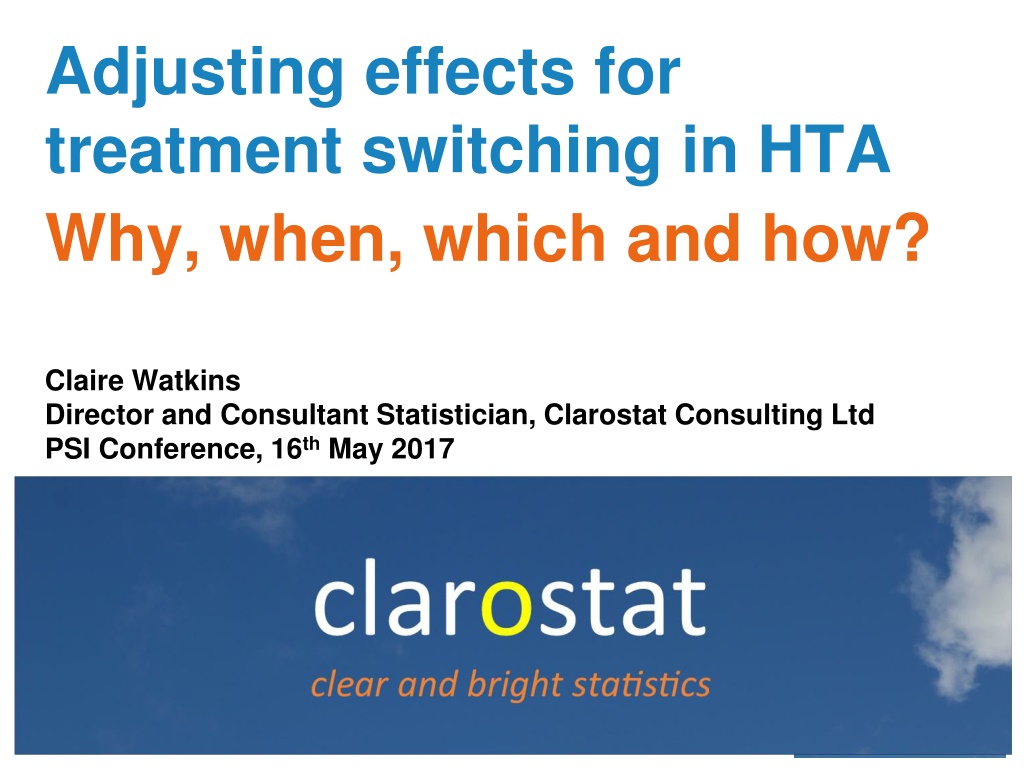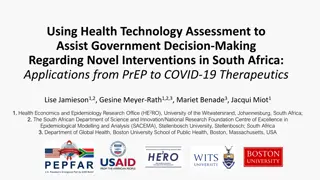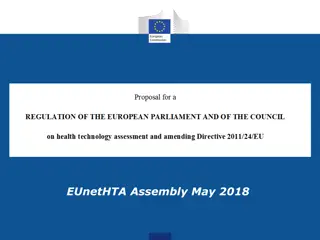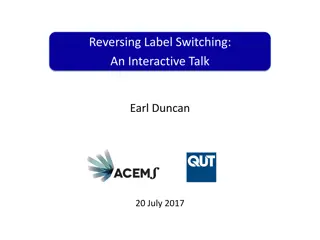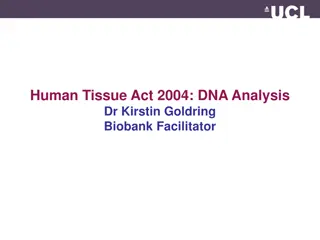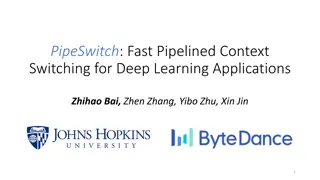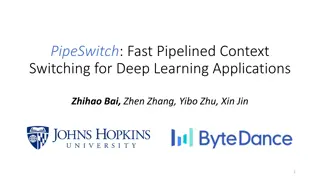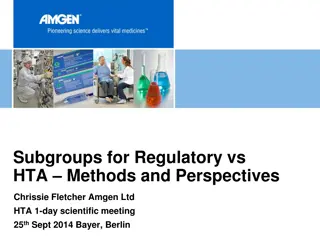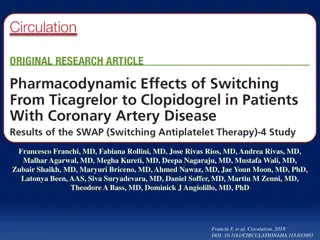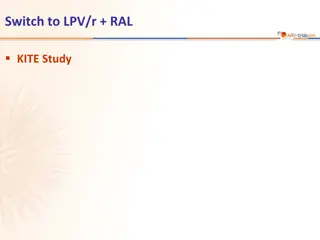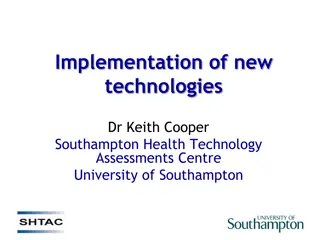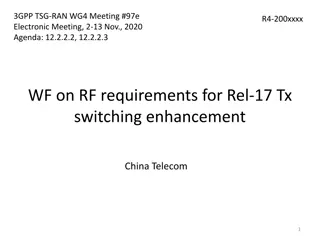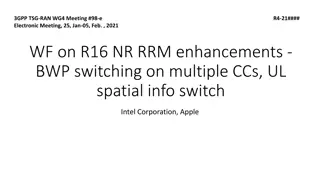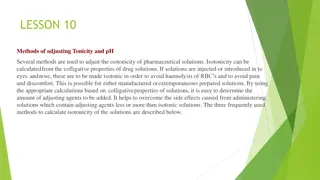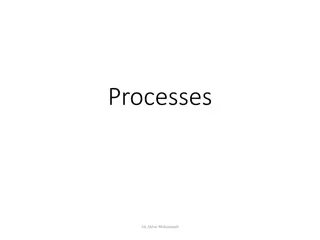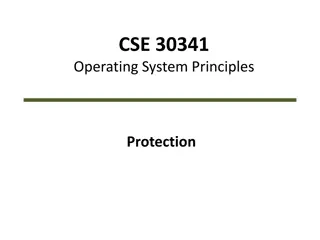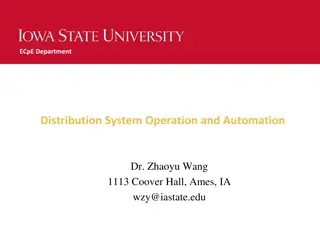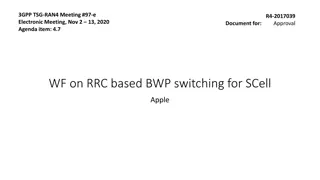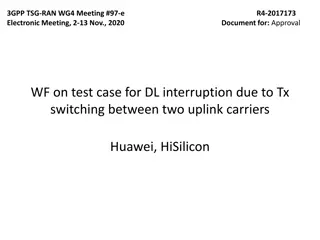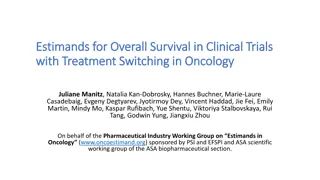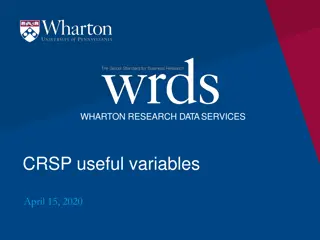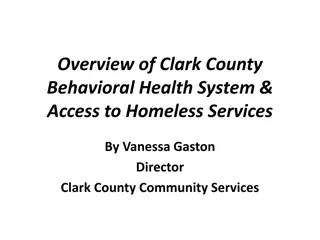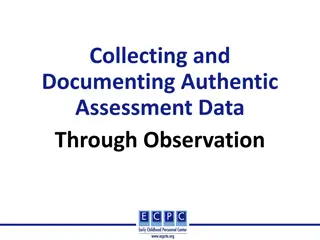Understanding Adjusting Effects for Treatment Switching in Health Technology Assessment (HTA)
Treatment switching in HTA refers to patients changing from one treatment to another during a clinical trial. It can impact the comparison of existing treatments to new therapies in HTA evaluations. Different methods are used to estimate survival rates in control groups without considering treatment switching. Regulatory agencies and HTA bodies have different viewpoints on adjusting for switching in trial analyses. Understanding the implications of treatment switching is crucial for accurate HTA evaluations.
Download Presentation

Please find below an Image/Link to download the presentation.
The content on the website is provided AS IS for your information and personal use only. It may not be sold, licensed, or shared on other websites without obtaining consent from the author. Download presentation by click this link. If you encounter any issues during the download, it is possible that the publisher has removed the file from their server.
E N D
Presentation Transcript
Adjusting effects for treatment switching in HTA Why, when, which and how? Claire Watkins Director and Consultant Statistician, Clarostat Consulting Ltd PSI Conference, 16thMay 2017
Background What do we mean by treatment switch/crossover? Patients in a parallel group RCT may switch or crossover to the alternative treatment at some point before an endpoint of interest occurs. Disease prog Randomise Survival Sunitinib We might build this into the trial protocol e.g. Sunitinib GIST trial (Demetri, 2012) Placebo Sunitinib Or it might happen spontaneously due to clinical practice in the region, if the treatment is already on the market e.g. Gefitinib IPASS trial (Fukuoka, 2011) Disease prog Randomise Standard clinical practice (inc gef) Gefitinib Survival Doublet chemo 2
Switching Regulatory vs HTA viewpoint Regulatory agency Health Technology Assessment (HTA) Agency Evaluate efficacy in clinical trial Evaluate effectiveness in real world setting Switch happened in clinical trial Switch real world (mostly) Do not adjust OS to remove switch - ITT primary Use plausible methods* to adjust OS to remove switch May consider switch adjusted OS as a supportive analysis If no plausible methods, use ITT Primary endpoint may not be OS anyway Key endpoint for lifetime cost effectiveness calculations is OS * Views of plausible methods differ by agency! 3
Why does switching matter for HTA? It all depends on the decision problem In HTA, the decision problem is often to compare: Current clinical practice without new therapy Potential future clinical practice including new therapy vs If there is switching and the new therapy is effective, ITT underestimates this difference How to estimate long term efficacy without switch? 4
Commonly used methods to estimate control arm survival in absence of switch (Latimer 2014, Watkins 2013) Naive methods 1. Exclude switchers 2. Censor at switch 3. Time varying covariate Simple to apply High levels of bias Assumption: no confounders (variables that influence switch and survival) Complex methods 1. Inverse Probability of Censoring Weighting (IPCW; observational) 2. Rank Preserving Structural Failure Time (RPSFT; randomisation based) 3. Iterative Parameter Estimation (IPE; randomisation based) 4. Two-stage Accelerated Failure Time (AFT) Harder to apply Try to reduce bias External data 5
Complex 1: IPCW (weight non-switched times) Control arm survival Compare to observed experimental arm survival (Robins 2000) Observed (ITT) control arm IPC weighted WEIGHT Non switchers Non switchers WEIGHT WEIGHT S Switchers Switchers WEIGHT S Assumption: The variables in the weight calculation fully capture all reasons for switching that are also linked to survival (i.e. no unmeasured confounders) Key Death time Censor time Switch time S 6 Weights represent how switch-like a patient is that has not yet switched
Complex 2/3: RPSFT/IPE (adjust post switch times) Control arm survival Compare to observed experimental arm survival (Robins 1991, White 2002, Branson 2002) Observed (ITT) control arm RPSFT/IPE adjusted Non switchers Non switchers S Switchers Switchers S Time off experimental Treatment multiplierx Time on experimental Time off experimental Time on experimental Key Assumption: Each cycle of treatment extends survival by a constant amount. Death time Censor time Switch time S (i.e. constant/common treatment effect) 7 Estimated by non-parametric G-estimation (RPSFT) or parametric model (IPE)
Complex (4): 2-Stage AFT (observational study) Control arm survival Compare to observed experimental arm survival (Latimer 2014) Observed (ITT) control arm 2-stage AFT adjusted Treat control arm as observational study post progression Re-baseline at progression Collect covariate data at progression Calculate effect of switch treatment adjusting for covariates Adjust switcher data and compare randomised arms Assumptions: The covariates fully capture all reasons for switching that are also linked to survival No time-dependent confounding between P and S P Non switchers P P S Switchers P S Key Death time Censor time Switch time Progression time S P (i.e. no unmeasured confounders) 8 Not valid if switch can occur before progression
Method selection process Specific process proposed in NICE DSU Technical Support Document 16 (Latimer 2014) Key steps (in general): 1. Can the model be fitted with available data? 2. If yes, is the model appropriate given the switching mechanism? 3. If yes, are the assumptions reasonable? 4. If yes, are the results plausible?
1. Data collection requirements for commonly used switch adjustment methods (Watkins 2016) Method switchers Exclude switchers Censor covariate varying Time /IPE RPSFTM 2-stage IPCW Data required Date of starting switch treatment * * Date of death/censoring Date of stopping switch treatment All baseline covariates that may influence switch decision and OS All time varying covariates that may influence switch decision and OS, collected until switch or death/censoring All time varying covariates that may influence switch decision and OS, collected until secondary baseline Date of secondary baseline (e.g. disease progression) ^ * for on-treatment approach only where efficacy stops at treatment end ^ if switch is only allowed after this point 10 Increasing data collection burden
2. Methods appropriate to switching mechanism switchers Exclude switchers Censor covariate varying Time /IPE RPSFTM 2-stage IPCW Method Switching mechanism <10% switch >80% switch/perfect switch predictor Switch occurs before progression for some patients Switch occurs a long time after progression for some patients Time on/off treatment or ITT survival is similar between arms (HR 1) = method not appropriate 11
3. Summary of key assumptions for switch adjustment methods Method ITT Exclude switchers Censor switchers Time varying covariate IPCW 2-stage Key assumptions Switch treatment ineffective No confounders (unlikely) No confounders (unlikely) No confounders (unlikely) No unmeasured confounders No unmeasured confounders (stronger assumption than IPCW as fewer covariates in model) Constant treatment effect Constant treatment effect Parametric distribution RPSFTM IPE 12
The 6 core analyses Produce as routine to understand data and switch patterns When switch occurred relative to randomisation, progression, stopping randomised treatment, death/censoring, e.g. via patient profile plots Analyse covariates that influence survival across all patients in the study regardless of treatment D A Number/% switched per arm, overall & of patients eligible for switch (e.g. exclude censored/died without prog) (IPCW/2-stage unreliable if too high) Compare control arm switchers and non-switchers for endpoints linked to survival but not switch-affected, e.g. progression-free survival B E Control arm patient characteristics split by switching status, to determine covariates that influence switch Summarise time on and off treatment by randomised arm (if similar, RPSFT/IPE unreliable) C F 13
Patient profile plot Example control arm patients 14
Assessing the assumptions: No confounders Na ve methods Determine if core Analysis C (covariates that influence switch) and Analysis D (covariates that influence survival) find any of the same covariates Determine if core Analysis E (non-switch affected endpoints linked to survival) shows a difference between switchers and non-switchers Ask a medical expert if disease progression or other variables are likely confounders. 15
Assessing the assumptions: No unmeasured confounders IPCW, 2-stage Determine if Analysis E (non-switch affected endpoints linked to survival) adjusted for the covariates (measured potential confounders) in the statistical model shows a difference between switchers and non-switchers Review patient profile plots from Analysis A for large time gaps between last key covariate data collection and switch (concern for IPCW,) or secondary baseline and switch (concern for 2-stage) Ask a medical expert and review literature for potential unmeasured confounders 16
Assessing the assumptions: Constant/common treatment effect RPSFT, IPE This is the hardest assumption to assess quantitatively, so seek medical expert opinion. Tipping point sensitivity analysis relaxing this assumption set the treatment effect in switchers to be smaller than for those initially randomized, until the adjusted survival gets close to the ITT result. Determine if that reduction in effect for switchers is clinically plausible. For trials with previous interim analyses, determine if the switch adjusted treatment effect from these methods is different for earlier and later analysis times Assuming no unmeasured confounders holds, determine if the treatment effect from second stage of 2-stage model is different to that from RPSFTM/IPE 17
Summary choice of switch adjustment method First things first Be clear on the decision problem(s) and target audience(s) Switch adjustment is not always necessary Define switch treatment carefully Determine what data were collected No method is universally best Be methodical and justify your choice 1. Can the model be fitted with available data? 2. If yes, is the model appropriate given the switching mechanism? 3. If yes, are the assumptions reasonable? 4. If yes, are the results plausible? 18
References Demetri GD et al. Complete longitudinal analyses of the randomized, placebo-controlled, Phase III trial of sunitinib in patients with gastrointestinal stromal tumor following imatinib failure. Clin Cancer Res 2012; 18:3170-3179 Fukuoka M et al. Biomarker analyses and final overall survival results from a Phase III, randomized, open label, first-line study of gefitinib versus carboplatin/paclitaxel in clinically selected patients with advanced non-small cell lung cancer in Asia (IPASS). J Clin Oncol 2011; 29(21):2866-2874 Watkins C et al. Adjusting overall survival for treatment switches: Commonly used methods and practical application. Pharm Stats 2013 Nov-Dec;12(6):348-57 Latimer NR and Abrams KR. NICE DSU Technical Support Document 16: Adjusting survival time estimates in the presence of treatment switching. (2014). Available from http://www.nicedsu.org.uk Robins J and Finkelstein D. Correcting for Noncompliance and Dependent Censoring in an AIDS Clinical Trial with Inverse Probability of Censoring Weighted (IPCW) Log-Rank Tests. Biometrics 2000; 56(3):779-788 Robins JM and Tsiatis A. Correcting for non-compliers in randomised trials using rank-preserving structural failure time models. Communications in Statistics - Theory and Methods 1991; 20:2609-2631. White IR et al. strbee: Randomization-based efficacy estimator. The Stata Journal 2002; 2(2):140-150 Branson M, Whitehead J. Estimating a treatment effect in survival strudies in which patients switch treatment. Statistics in Medicine 2002; 21:2449 2463. Watkins CL, Latimer N, Wang J, Wright EJ. Guidance on selecting appropriate methods when considering adjusting overall survival for treatment switch in oncology studies. Value in Health 2016; 19(7): A398 19
Q & A 20
